Check out these fascinating articles for more great ideas:
List of All Roman Emperors and Empresses Chronologically organized:
Ancient Greek Cities or Kingdoms of Interest
Ancient Greek Rulers of Interest
Related to Christianity
Ancient Greek / Roman Deities, Locations and more:
Astrological Ancient Coins - Just some of the Ideas for Owning, available inside my eBay store.
Byzantine Coins Browse by Category:
Welcome to the best ancient Greek, Roman, Biblical, Medieval, Byzantine
online coin store. Up above are pages you can click on that give you great
ideas about the types of coins available for sale. Items are usually shipped
daily so you can rest assured to make these as great unique gifts for both
men and women. As a numismatist, I believe ancient coins make one of the
best investments. Collectors of numismatic coins may fall in love with this
old money. Ancient coins come in both bronze and precious metals such as
silver and gold. What is great is that you can great value as these types of
coins are not popularized in places such as the antiques roadshow or pawn
stars. You can see for yourself by the feedback, that there is over 99%
positive experience for anyone that shops here and that you are dealing with
one of the best, most reputable coin dealers on the internet. Coin
collecting is easy and fun with the wealth of information presented. It is
an amazing feeling to hold historical currency from thousands of years ago.
These coins are worth money not just for their intrinsic, but also
historical, numismatic and collector value. Investing money into an ancient
coin collection is for anyone who values rarity, beauty and so much more
that make up this great hobby. You may be looking for advice on how or where
to start. There are many great links available in my eBay store that cover
many great topics on ancient coins. Anything that you buy here is of great
value, especially for the long term and the short term. The prices you can
buy coins here are negotiable via the 'make offer' feature that is available
on all items so you can get amazingly good deals buying coins and a
selection of rarities not found anywhere else. The collecting guide above is
a great list that can be used as a tool to collect almost every emperor or
empress as it is in chronological order and allows you to search my store
for those coins by clicking on them. Other great topics, such as Ancient
Greek and Roman Commemorative coins deals with the most interesting
commemorative coins you can buy. Happy shopping. I look forward to dealing
with you for a lifetime. Some of the oldest, most valuable ancient coins
that you may find here are that of Julius Caesar and Alexander the Great.
Exchange your modern money for ancient money by buying an amazing ancient
coin today. A great gift for yourself and others.
To help people find my store
12 caesars coins
|
'Saint' Constantine the Great 307-337AD Authentic Ancient Roman Coins for Sale OnlineBuy authentic Constantine I, the Great coins, from 307-337AD from a trusted ancient coin dealer and expert, Ilya Zlobin. He made Christianity the official religion of the Roman empire and was responsible for the Council of Nicaea in which they standardized Christianity. Read his biography, watch a video presentation about him and explore a selection of his coins from a trusted ancient coin seller. Get incredible value with a LIFETIME GUARANTEE of AUTHENTICITY. Also every item purchased here comes with a beautiuful custom-made certificate of authenticity, complete with professional description, research, professional photograph and historical synopsis, a $50-$100 value, absolutely free, signed by world-renowned ancient coin expert, Ilya Zlobin. A fun way to explore history, making a great gift, great for coin collecting and investment!
Constantine I 'The Great'- Roman Emperor: 307-337
A.D. - Constantine the Great (Latin: Flavius Valerius Aurelius Constantinus Augustus; 27 February c. 272 – 22 May 337), also known as Constantine I or Saint Constantine, was Roman Emperor from 306 to 337. Well known for being the first Roman emperor to be converted to Christianity, Constantine and co-Emperor Licinius issued the Edict of Milan in 313, which proclaimed tolerance of all religions throughout the empire. 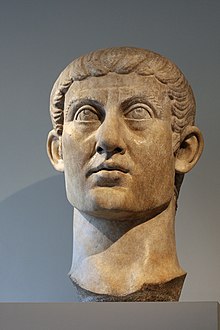
Constantine defeated the emperors Maxentius and Licinius during civil wars. He also fought successfully against the Franks, Alamanni, Visigoths, and Sarmatians during his reign — even resettling parts of Dacia which had been abandoned during the previous century. Constantine built a new imperial residence at Byzantium, naming it New Rome. However, in Constantine's honor, people called it Constantinople, which would later be the capital of what is now known as the Byzantine Empire for over one thousand years. Because of this, he is thought of as the founder of the Byzantine Empire. Flavius Valerius Constantinus, as he was originally named, was born in the city of Naissus, Dardania province of Moesia, in present-day Niš, Serbia, on 27 February of an uncertain year, probably near 272. His father was Flavius Constantius, a native of Dardania province of Moesia (later Dacia Ripensis). Constantius was a tolerant and politically skilled man. Constantine probably spent little time with his father. Constantius was an officer in the Roman army, part of the Emperor Aurelian's imperial bodyguard. Constantius advanced through the ranks, earning the governorship of Dalmatia from Emperor Diocletian, another of Aurelian's companions from Illyricum, in 284 or 285.Constantine's mother was Helena, a Bithynian woman of low social standing.It is uncertain whether she was legally married to Constantius or merely his concubine Helena gave birth to the future emperor Constantine I on 27 February of an uncertain year soon after 270 (probably around 272). At the time, she was in Naissus (Niš, Serbia). In order to obtain a wife more consonant with his rising status, Constantius divorced Helena some time before 289, when he married Theodora, Maximian's daughter.(The narrative sources date the marriage to 293, but the Latin panegyric of 289 refers to the couple as already married). Helena and her son were dispatched to the court of Diocletian at Nicomedia, where Constantine grew to be a member of the inner circle. Helena never remarried and lived for a time in obscurity, though close to her only son, who had a deep regard and affection for her. She received the title of Augusta in 325 and died in 330 with her son at her side. She was buried in the Mausoleum of Helena, outside Rome on the Via Labicana. Her sarcophagus is on display in the Pio-Clementine Vatican Museum, although the connection is often questioned, next to her is the sarcophagus of her granddaughter Saint Constantina (Saint Constance). The elaborate reliefs contain hunting scenes. During her life, she gave many presents to the poor, released prisoners and mingled with the ordinary worshippers in modest attire. Constantine received a formal education at Diocletian's court, where he learned Latin literature, Greek, and philosophy. On 1 May 305, Diocletian, as a result of a debilitating sickness taken in the winter of 304–5, announced his resignation. In a parallel ceremony in Milan, Maximian did the same. Lactantius states that Galerius manipulated the weakened Diocletian into resigning, and forced him to accept Galerius' allies in the imperial succession. According to Lactantius, the crowd listening to Diocletian's resignation speech believed, until the very last moment, that Diocletian would choose Constantine and Maxentius (Maximian's son) as his successors. It was not to be: Constantius and Galerius were promoted to Augusti, while Severus and Maximin were appointed their Caesars respectively. Constantine and Maxentius were ignored. Constantine recognized the implicit danger in remaining at Galerius' court, where he was held as a virtual hostage. His career depended on being rescued by his father in the west. Constantius was quick to intervene. In the late spring or early summer of 305, Constantius requested leave for his son, to help him campaign in Britain. After a long evening of drinking, Galerius granted the request. Constantine's later propaganda describes how he fled the court in the night, before Galerius could change his mind. He rode from post-house to post-house at high speed, hamstringing every horse in his wake.By the time Galerius awoke the following morning, Constantine had fled too far to be caught. Constantine joined his father in Gaul, at Bononia (Boulogne) before the summer of 305. From Bononia they crossed the Channel to Britain and made their way to Eboracum (York), capital of the province of Britannia Secunda and home to a large military base. Constantine was able to spend a year in northern Britain at his father's side, campaigning against the Picts beyond Hadrian's Wall in the summer and autumn. Constantius's campaign, like that of Septimius Severus before it, probably advanced far into the north without achieving great success. Constantius had become severely sick over the course of his reign, and died on 25 July 306 in Eboracum (York). Before dying, he declared his support for raising Constantine to the rank of full Augustus. The Alamannic king Chrocus, a barbarian taken into service under Constantius, then proclaimed Constantine as Augustus. The troops loyal to Constantius' memory followed him in acclamation. Gaul and Britain quickly accepted his rule; Iberia, which had been in his father's domain for less than a year, rejected it. Constantine sent Galerius an official notice of Constantius's death and his own acclamation. Along with the notice, he included a portrait of himself in the robes of an Augustus. The portrait was wreathed in bay. He requested recognition as heir to his father's throne, and passed off responsibility for his unlawful ascension on his army, claiming they had "forced it upon him".Galerius was put into a fury by the message; he almost set the portrait on fire. His advisers calmed him, and argued that outright denial of Constantine's claims would mean certain war.Galerius was compelled to compromise: he granted Constantine the title "Caesar" rather than "Augustus" (the latter office went to Severus instead). Wishing to make it clear that he alone gave Constantine legitimacy, Galerius personally sent Constantine the emperor's traditional purple robes. Constantine accepted the decision. Constantine's share of the Empire consisted of Britain, Gaul, and Spain. Because Constantine was still largely untried and had a hint of illegitimacy about him, he relied on his father's reputation in his early propaganda: the earliest panegyrics to Constantine give as much coverage to his father's deeds as to those of Constantine himself. Constantine's military skill and building projects soon gave the panegyrist the opportunity to comment favorably on the similarities between father and son, and Eusebius remarked that Constantine was a "renewal, as it were, in his own person, of his father's life and reign". Constantinian coinage, sculpture and oratory also shows a new tendency for disdain towards the "barbarians" beyond the frontiers. After Constantine's victory over the Alemanni, he minted a coin issue depicting weeping and begging Alemannic tribesmen—"The Alemanni conquered"—beneath the phrase "Romans' rejoicing".There was little sympathy for these enemies. As his panegyrist declared: "It is a stupid clemency that spares the conquered foe." In 310, a dispossessed and power-hungry Maximian rebelled against Constantine while Constantine was away campaigning against the Franks. Maximian had been sent south to Arles with a contingent of Constantine's army, in preparation for any attacks by Maxentius in southern Gaul. He announced that Constantine was dead, and took up the imperial purple. In spite of a large donative pledge to any who would support him as emperor, most of Constantine's army remained loyal to their emperor, and Maximian was soon compelled to leave. Constantine soon heard of the rebellion, abandoned his campaign against the Franks, and marched his army up the Rhine. At Cabillunum (Chalon-sur-Saône), he moved his troops onto waiting boats to row down the slow waters of the Saône to the quicker waters of the Rhone. He disembarked at Lugdunum (Lyon).Maximian fled to Massilia (Marseille), a town better able to withstand a long siege than Arles. It made little difference, however, as loyal citizens opened the rear gates to Constantine. Maximian was captured and reproved for his crimes. Constantine granted some clemency, but strongly encouraged his suicide. In July 310, Maximian hanged himself. The death of Maximian required a shift in Constantine's public image. He could no longer rely on his connection to the elder emperor Maximian, and needed a new source of legitimacy.In a speech delivered in Gaul on 25 July 310, the anonymous orator reveals a previously unknown dynastic connection to Claudius II, a third-century emperor famed for defeating the Goths and restoring order to the empire. Breaking away from tetrarchic models, the speech emphasizes Constantine's ancestral prerogative to rule, rather than principles of imperial equality. The new ideology expressed in the speech made Galerius and Maximian irrelevant to Constantine's right to rule. Indeed, the orator emphasizes ancestry to the exclusion of all other factors: "No chance agreement of men, nor some unexpected consequence of favor, made you emperor," the orator declares to Constantine. 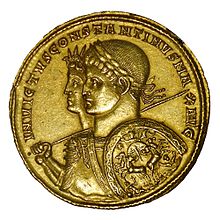
in it Apollo's patronage of Augustus and the arts; and to Christians, who found solar monotheism less objectionable than the traditional pagan pantheon.
The oration also moves away from the religious ideology of the Tetrarchy, with its focus on twin dynasties of Jupiter and Hercules. Instead, the orator proclaims that Constantine experienced a divine vision of Apollo and Victory granting him laurel wreaths of health and a long reign. In the likeness of Apollo Constantine recognized himself as the saving figure to whom would be granted "rule of the whole world", as the poet Virgil had once foretold. The oration's religious shift is paralleled by a similar shift in Constantine's coinage. In his early reign, the coinage of Constantine advertised Mars as his patron. From 310 on, Mars was replaced by Sol Invictus, a god conventionally identified with Apollo. By the middle of 310, Galerius had become too ill to involve himself in imperial politics. His final act survives: a letter to the provincials posted in Nicomedia on 30 April 311, proclaiming an end to the persecutions, and the resumption of religious toleration. He died soon after the edict's proclamation, destroying what little remained of the tetrarchy. Maximin mobilized against Licinius, and seized Asia Minor. A hasty peace was signed on a boat in the middle of the Bosphorus. While Constantine toured Britain and Gaul, Maxentius prepared for war.He fortified northern Italy, and strengthened his support in the Christian community by allowing it to elect a new Bishop of Rome, Eusebius. Constantine's advisers and generals cautioned against preemptive attack on Maxentius; even his soothsayers recommended against it, stating that the sacrifices had produced unfavorable omens. Constantine, with a spirit that left a deep impression on his followers, inspiring some to believe that he had some form of supernatural guidance, ignored all these cautions. Early in the spring of 312,Constantine crossed the Cottian Alps with a quarter of his army, a force numbering about 40,000.The first town his army encountered was Segusium (Susa, Italy), a heavily fortified town that shut its gates to him. Constantine ordered his men to set fire to its gates and scale its walls. He took the town quickly. Constantine ordered his troops not to loot the town, and advanced with them into northern Italy. At the approach to the west of the important city of Augusta Taurinorum (Turin, Italy), Constantine met a large force of heavily armed Maxentian cavalry. In the ensuing battle Constantine's army encircled Maxentius' cavalry, flanked them with his own cavalry, and dismounted them with blows from his soldiers' iron-tipped clubs. Constantine's armies emerged victorious. Turin refused to give refuge to Maxentius' retreating forces, opening its gates to Constantine instead. Other cities of the north Italian plain sent Constantine embassies of congratulation for his victory. He moved on to Milan, where he was met with open gates and jubilant rejoicing. Constantine rested his army in Milan until mid-summer 312, when he moved on to Brixia (Brescia). Brescia's army was easily dispersed, and Constantine quickly advanced to Verona, where a large Maxentian force was camped. Ruricius Pompeianus, general of the Veronese forces and Maxentius' praetorian prefect, was in a strong defensive position, since the town was surrounded on three sides by the Adige. Constantine sent a small force north of the town in an attempt to cross the river unnoticed. Ruricius sent a large detachment to counter Constantine's expeditionary force, but was defeated. Constantine's forces successfully surrounded the town and laid siege. Ruricius gave Constantine the slip and returned with a larger force to oppose Constantine. Constantine refused to let up on the siege, and sent only a small force to oppose him. In the desperately fought encounter that followed, Ruricius was killed and his army destroyed.Verona surrendered soon afterwards, followed by Aquileia, Mutina (Modena), and Ravenna. The road to Rome was now wide open to Constantine. Maxentius prepared for the same type of war he had waged against Severus and Galerius: he sat in Rome and prepared for a siege. He still controlled Rome's praetorian guards, was well-stocked with African grain, and was surrounded on all sides by the seemingly impregnable Aurelian Walls. He ordered all bridges across the Tiber cut, reportedly on the counsel of the gods, and left the rest of central Italy undefended; Constantine secured that region's support without challenge. Constantine progressed slowly along the Via Flaminia, allowing the weakness of Maxentius to draw his regime further into turmoil. Maxentius' support continued to weaken: at chariot races on 27 October, the crowd openly taunted Maxentius, shouting that Constantine was invincible. Maxentius, no longer certain that he would emerge from a siege victorious, built a temporary boat bridge across the Tiber in preparation for a field battle against Constantine. On 28 October 312, the sixth anniversary of his reign, he approached the keepers of the Sibylline Books for guidance. The keepers prophesied that, on that very day, "the enemy of the Romans" would die. Maxentius advanced north to meet Constantine in battle. Maxentius organized his forces—still twice the size of Constantine's—in long lines facing the battle plain, with their backs to the river. Constantine's army arrived at the field bearing unfamiliar symbols on either its standards or its soldiers' shields. Constantine was visited by a dream the night before the battle, wherein he was advised "to mark the heavenly sign of God on the shields of his soldiers...by means of a slanted letter X with the top of its head bent round, he marked Christ on their shields." Eusebius describes the sign as Chi (Χ) traversed by Rho (Ρ): ☧, a symbol representing the first two letters of the Greek spelling of the word Christos or Christ. Constantine deployed his own forces along the whole length of Maxentius' line. He ordered his cavalry to charge, and they broke Maxentius' cavalry. He then sent his infantry against Maxentius' infantry, pushing many into the Tiber where they were slaughtered and drowned. The battle was brief: Maxentius' troops were broken before the first charge. Maxentius' horse guards and praetorians initially held their position, but broke under the force of a Constantinian cavalry charge; they also broke ranks and fled to the river. Maxentius rode with them, and attempted to cross the bridge of boats, but he was pushed by the mass of his fleeing soldiers into the Tiber, and drowned. In RomeConstantine entered Rome on 29 October.He staged a grand adventus in the city, and was met with popular jubilation. Maxentius' body was fished out of the Tiber and decapitated. His head was paraded through the streets for all to see. Unlike his predecessors, Constantine neglected to make the trip to the Capitoline Hill and perform customary sacrifices at the Temple of Jupiter. He did, however, choose to honor the Senatorial Curia with a visit, where he promised to restore its ancestral privileges and give it a secure role in his reformed government: there would be no revenge against Maxentius' supporters.In response, the Senate decreed him "title of the first name", which meant his name would be listed first in all official documents, and acclaimed him as "the greatest Augustus". He issued decrees returning property lost under Maxentius, recalling political exiles, and releasing Maxentius' imprisoned opponents. In the following years, Constantine gradually consolidated his military superiority over his rivals in the crumbling Tetrarchy. In 313, he met Licinius in Milan to secure their alliance by the marriage of Licinius and Constantine's half-sister Constantia. During this meeting, the emperors agreed on the so-called Edict of Milan,officially granting full tolerance to Christianity and all religions in the Empire.The document had special benefits for Christians, legalizing their religion and granting them restoration for all property seized during Diocletian's persecution. In the year 320, Licinius reneged on the religious freedom promised by the Edict of Milan in 313 and began to oppress Christians anew, generally without bloodshed, but resorting to confiscations and sacking of Christian office-holders.That became a challenge to Constantine in the West, climaxing in the great civil war of 324. Licinius, aided by Goth mercenaries, represented the past and the ancient Pagan faiths. Constantine and his Franks marched under the standard of the labarum, and both sides saw the battle in religious terms. Outnumbered, but fired by their zeal, Constantine's army emerged victorious in the Battle of Adrianople. Licinius fled across the Bosphorus and appointed Martius Martinianus, the commander of his bodyguard, as Caesar, but Constantine next won the Battle of the Hellespont, and finally the Battle of Chrysopolis on 18 September 324.Licinius and Martinianus surrendered to Constantine at Nicomedia on the promise their lives would be spared: they were sent to live as private citizens in Thessalonica and Cappadocia respectively, but in 325 Constantine accused Licinius of plotting against him and had them both arrested and hanged; Licinius's son (the son of Constantine's half-sister) was also killed. Thus Constantine became the sole emperor of the Roman Empire. Foundation of ConstantinopleLicinius' defeat came to represent the defeat of a rival center of Pagan and Greek-speaking political activity in the East, as opposed to the Christian and Latin-speaking Rome, and it was proposed that a new Eastern capital should represent the integration of the East into the Roman Empire as a whole, as a center of learning, prosperity, and cultural preservation for the whole of the Eastern Roman Empire . Among the various locations proposed for this alternative capital, Constantine appears to have toyed earlier with Serdica (present-day Sofia), as he was reported saying that "Serdica is my Rome". Sirmium and Thessalonica were also considered. Eventually, however, Constantine decided to work on the Greek city of Byzantium, which offered the advantage of having already been extensively rebuilt on Roman patterns of urbanism, during the preceding century, by Septimius Severus and Caracalla, who had already acknowledged its strategic importance. The city was then renamed Constantinopolis ("Constantine's City" or Constantinople in English), and issued special commemorative coins in 330 to honor the event. The new city was protected by the relics of the True Cross, the Rod of Moses and other holy relics, though a cameo now at the Hermitage Museum also represented Constantine crowned by the tyche of the new city. The figures of old gods were either replaced or assimilated into a framework of Christian symbolism. Constantine built the new Church of the Holy Apostles on the site of a temple to Aphrodite. Generations later there was the story that a divine vision led Constantine to this spot, and an angel no one else could see, led him on a circuit of the new walls. The capital would often be compared to the 'old' Rome as Nova Roma Constantinopolitana, the "New Rome of Constantinople". 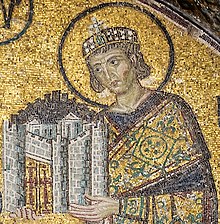
Religious policyConstantine is perhaps best known for being the first "Christian" Roman
emperor. Scholars debate whether Constantine adopted his mother
St. Helena's
Christianity in his youth, or whether he adopted it gradually over the course of
his life. However, Constantine certainly did not patronize Christianity alone. After gaining victory in the Battle of the Milvian Bridge (312), a triumphal arch—the Arch of Constantine—was built (315) to celebrate his triumph. The arch is most notably decorated with images of the goddess Victoria and, at the time of its dedication, sacrifices to gods like Apollo, Diana, and Hercules were made. Most notably absent from the Arch are any depictions whatsoever regarding Christian symbolism. Later in 321, Constantine instructed that Christians and non-Christians should be united in observing the venerable day of the sun, referencing the sun-worship that Aurelian had established as an official cult. Furthermore, and long after his oft alleged "conversion" to Christianity, Constantine's coinage continued to carry the symbols of the sun. Even after the pagan gods had disappeared from the coinage, Christian symbols appeared only as Constantine's personal attributes: the chi rho between his hands or on his labarum, but never on the coin itself. Even when Constantine dedicated the new capital of Constantinople, which became the seat of Byzantine Christianity for a millennium, he did so wearing the Apollonian sun-rayed Diadem; no Christian symbols were present at this dedication. Constantine made new laws regarding the Jews. They were forbidden to own Christian slaves or to circumcise their slaves. Administrative reformsBeginning in the mid-3rd century the emperors began to favor members of the equestrian order over senators, who had had a monopoly on the most important offices of state. Senators were stripped of the command of legions and most provincial governorships (as it was felt that they lacked the specialized military upbringing needed in an age of acute defense needs), such posts being given to equestrians by Diocletian and his colleagues—following a practice enforced piecemeal by their predecessors. The emperors however, still needed the talents and the help of the very rich, who were relied on to maintain social order and cohesion by means of a web of powerful influence and contacts at all levels. Exclusion of the old senatorial aristocracy threatened this arrangement. In 326, Constantine reversed this pro-equestrian trend, raising many administrative positions to senatorial rank and thus opening these offices to the old aristocracy, and at the same time elevating the rank of already existing equestrians office-holders to senator, eventually wiping out the equestrian order—at least as a bureaucratic rank—in the process. One could become a senator, either by being elected praetor or (in most cases) by fulfilling a function of senatorial rank: from then on, holding of actual power and social status were melded together into a joint imperial hierarchy. At the same time, Constantine gained with this the support of the old nobility, as the Senate was allowed itself to elect praetors and quaestors, in place of the usual practice of the emperors directly creating new magistrates (adlectio). The Senate as a body remained devoid of any significant power; nevertheless, the senators, who had been marginalized as potential holders of imperial functions during the 3rd century, could now dispute such positions alongside more upstart bureaucrats. Some modern historians see in those administrative reforms an attempt by Constantine at reintegrating the senatorial order into the imperial administrative elite to counter the possibility of alienating pagan senators from a Christianized imperial rule. Constantine's reforms had to do only with the civilian administration: the military chiefs, who since the Crisis of the Third Century had risen from the ranks, remained outside the senate, in which they were included only by Constantine's children. Monetary reformsAfter the runaway inflation of the third century, associated with the production of fiat money to pay for public expenses, Diocletian had tried unsuccessfully to reestablish trustworthy minting of silver and billon coins. The failure of the various Diocletianic attempts at the restoration of a functioning silver coin resided in the fact that the silver currency was overvalued in terms of its actual metal content, and therefore could only circulate at much discounted rates. Minting of the Diocletianic "pure" silver argenteus ceased, therefore, soon after 305, while the billon currency continued to be used until the 360s. From the early 300s on, Constantine forsook any attempts at restoring the silver currency, preferring instead to concentrate on minting large quantities of good standard gold pieces—the solidus, 72 of which made a pound of gold. New (and highly debased) silver pieces would continue to be issued during Constantine's later reign and after his death, in a continuous process of retariffing, until this billon minting eventually ceased, de jure, in 367, with the silver piece being de facto continued by various denominations of bronze coins, the most important being the centenionalis. Later emperors like Julian the Apostate tried to present themselves as advocates of the humiles by insisting on trustworthy mintings of the bronze currency. Constantine's monetary policy were closely associated with his religious ones, in that increased minting was associated with measures of confiscation—taken since 331 and closed in 336—of all gold, silver and bronze statues from pagan temples, who were declared as imperial property and, as such, as monetary assets. Two imperial commissioners for each province had the task of getting hold of the statues and having them melded for immediate minting—with the exception of a number of bronze statues who were used as public monuments for the beautification of the new capital in Constantinople. Later campaignsConstantine considered Constantinople as his capital and permanent residence. He lived there for a good portion of his later life. He rebuilt Trajan's bridge across the Danube, in hopes of reconquering Dacia, a province that had been abandoned under Aurelian. In the late winter of 332, Constantine campaigned with the Sarmatians against the Goths. The weather and lack of food cost the Goths dearly: reportedly, nearly one hundred thousand died before they submitted to Rome. In 334, after Sarmatian commoners had overthrown their leaders, Constantine led a campaign against the tribe. He won a victory in the war and extended his control over the region, as remains of camps and fortifications in the region indicate.Constantine resettled some Sarmatian exiles as farmers in Illyrian and Roman districts, and conscripted the rest into the army. Constantine took the title Dacicus maximus in 336. Sickness and deathConstantine had known death would soon come. Within the Church of the Holy Apostles, Constantine had secretly prepared a final resting-place for himself.It came sooner than he had expected. Soon after the Feast of Easter 337, Constantine fell seriously ill. He left Constantinople for the hot baths near his mother's city of Helenopolis (Altinova), on the southern shores of the Gulf of İzmit. There, in a church his mother built in honor of Lucian the Apostle, he prayed, and there he realized that he was dying. Seeking purification, he became a catechumen, and attempted a return to Constantinople, making it only as far as a suburb of Nicomedia. He summoned the bishops, and told them of his hope to be baptized in the River Jordan, where Christ was written to have been baptized. He requested the baptism right away. The bishops, Eusebius records, "performed the sacred ceremonies according to custom". He chose the Arianizing bishop Eusebius of Nicomedia, bishop of the city where he lay dying, as his baptizer. In postponing his baptism, he followed one custom at the time which postponed baptism until after infancy. Constantine died soon after at a suburban villa called Achyron, on the last day of the fifty-day festival of Pentecost directly following Pascha (or Easter), on 22 May 337. Following his death, his body was transferred to Constantinople and buried in the Church of the Holy Apostles there. He was succeeded by his three sons born of Fausta, Constantine II, Constantius II and Constans. A number of relatives were killed by followers of Constantius, notably Constantine's nephews Dalmatius (who held the rank of Caesar) and Hannibalianus, presumably to eliminate possible contenders to an already complicated succession. He also had two daughters, Constantina and Helena, wife of Emperor Julian. Legacy The Byzantine Empire considered Constantine its founder and the Holy Roman Empire reckoned him among the venerable figures of its tradition. In the later Byzantine state, it had become a great honor for an emperor to be hailed as a "new Constantine". Ten emperors, including the last emperor of Byzantium, carried the name. Most Eastern Christian churches consider Constantine a saint (Άγιος Κωνσταντίνος, Saint Constantine). In the Byzantine Church he was called isapostolos (Ισαπόστολος Κωνσταντίνος) —an equal of the Apostles. Niš airport is named Constantine the Great in honor of his birth in Naissus. | |
|
www.TrustedCoins.commm Buy Real Ancient Greek Roman Biblical Byzantine Coins and Artifacts |
||
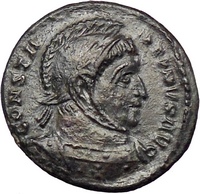
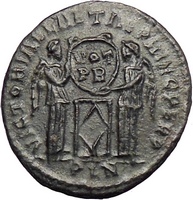
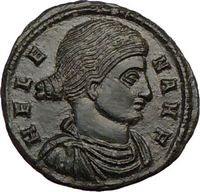
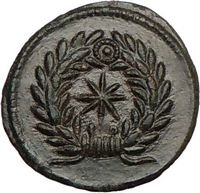


.JPG/400px-0_Constantinus_I_-_Palazzo_dei_Conservatori_(2).JPG)